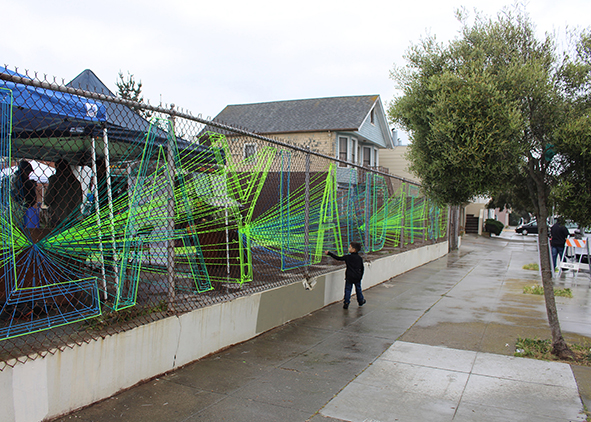Collaborative multi-use community space in San Francisco, CA (USA)
DOI:
https://doi.org/10.19229/2464-9309/4132018Keywords:
social architecture, tactical urbanism, multi-use park, community building, youth participation in the planning processAbstract
This paper illustrates the state of the art of temporary design as a tool of Tactical Urbanism with a specific focus on a successful regeneration project in San Francisco. Playland at 43rd Avenue is a community-driven, participatory project on an under-utilized lot. The paper illustrates the community design process, methodology, design and construction phases, stakeholders involved, sponsor and budget required for the project’s realization. Interesting and unique aspect of the project is the involvement of youth in the whole planning process – from neighborhood’s existing needs assessment to the idea generation, design, construction and maintenance of this project that has been enjoyed by all ages. Focusing on the specifics of the design and implementation process of the project it is important to explain its success and to offer a blueprint for its replicability.
Downloads
Article Metrics Graph
References
Andres, L. (2013), “Differential Spaces, Power Hierarchy and Collaborative Planning: A Critique of the Role of Temporary Uses in Shaping and Making Places”, in Urban Studies, vol. 50, n. 4, pp. 759-775.
Bazzu, P. and Talu, V. (2016), Tactical Urbanism Italy 5, TaMaLaCà srl, Sassari.
Bela, J. (2015), Hacking Public Space – Formalizing Parklets and Beyond. [Online] available at: www.100resilientcities.org [Accessed 30 September 2018].
Bishop, P. and Williams, L. (2012), The temporary city, Routledge, London and New York.
Chase, J., Crawford, M. and Kaliski, J. (eds) (1999), Everyday Urbanism, Monacelli Press, New York.
de Certeau, M. (1984), The Practice of Everyday Life, University of California Press, Berkeley.
Gill, T. (2007), No Fear – How to grow up in a risk adverse society, Calouste Gulbenkian Foundation, London.
Koolhaas, R. and Mau, B. (1995), S, M, L, XL, The Monacelli Press, New York.
Haydn, F. and Temel, R. (eds) (2006), Temporary Urban Spaces – Concepts for the Use of the City Spaces, Birkhauser, Basilea.
Lydon, M., Garcia, M. and Duany, A. (2015), Tactical Urbanism – Short-term Action for Long-term Change, Island Press, London.
McClelland, E. (2014), The Guerilla Bureaucrat. [Online] Available at: nextcity.org/features/view/the-guerilla-bureaucrat [Accessed 30 September 2018].
Oswalt, P., Overmayer, K. and Misselwitz, P. (eds) (2013), Urban Catalyst – The Power of Temporary Use, Dom Publishers, Berlin.
University of Sheffield (2015), Temporary Use Practice – SEEDS Workpackage 3, South Yorkshire Forest Partnership / Sheffield City Council, Sheffield (UK).
Urban Catalyst (2003), Urban Catalysts – Strategies for temporary uses – potential for development of urban residual areas in European metropolises, Studio Urban Catalyst, Berlin.
Valente, R. (2017), “American Design Activism”, in Techne, n. 14, pp. 147-157.
Valente, R. (2015), “Processi partecipativi e attivismo progettuale negli Stati Uniti”, in Atti delle Giornate Internazionali di Studio – Abitare Insieme Dimensione condivisa del progetto di futuro, Clean edizioni, Napoli, pp. 1409-1419.
Valente, R. (2014), “Urban Regeneration in San Francisco (CA, USA) – Environmental design for public realm”, in Esempi di Architettura, vol. 1, n. 1, pp. 70-77.

Downloads
Published
How to Cite
Issue
Section
License
This Journal is published under Creative Commons Attribution Licence 4.0 (CC-BY).
License scheme | Legal code
This License allows anyone to:
Share: copy and redistribute the material in any medium or format.
Adapt: remix, transform, and build upon the material for any purpose, even commercially.
Under the following terms
Attribution: Users must give appropriate credit, provide a link to the license, and indicate if changes were made; users may do so in any reasonable manner, but not in any way that suggests the licensor endorses them or their use.
No additional restrictions: Users may not apply legal terms or technological measures that legally restrict others from doing anything the license permits.
Notices
Users do not have to comply with the license for elements of the material in the public domain or where your use is permitted by an applicable exception or limitation.
No warranties are given. The license may not give users all of the permissions necessary for their intended use. For example, other rights such as publicity, privacy, or moral rights may limit how you use the material.


















































































